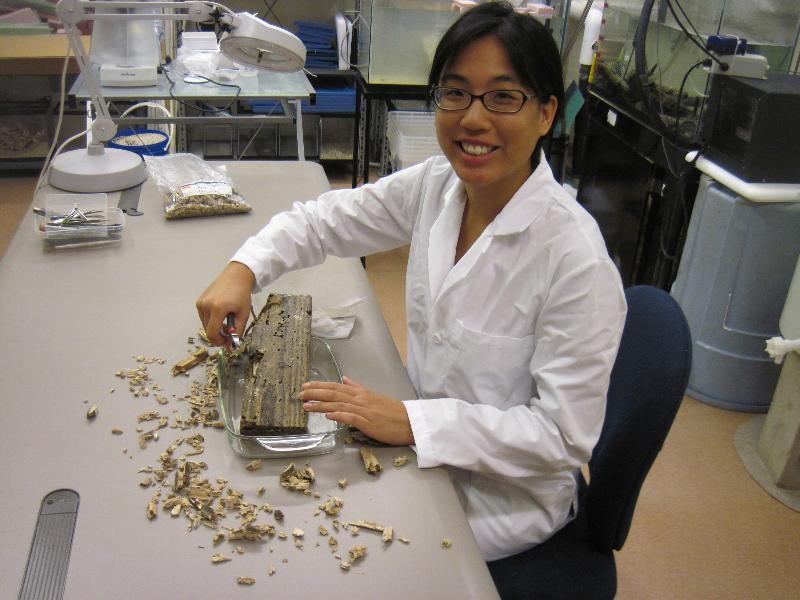Greetings!
This month's newsletter highlights our research on wood-eating clams known as shipworms. With the help of bacterial symbionts, these wormlike marine bivalves are among the few animals on earth that can live on a diet composed solely of wood! Our recent genomic research has revealed that shipworms use a new type of digestive organ not seen in any other animal -- a gland that is part animal and part bacteria! Read on to learn how these strange creatures eat wood and why they may hold clues to the future of renewable alternative energy. And, as always, follow our expeditions and other news from the marine world on our Facebook and Twitter pages!   |
Shipworms: wood digestion powered by hybrid drive?
|
|
Dr. Jennifer Fung dissecting shipworms from a pine log collected in Puget Sound, Washington  | Most animals have bacteria in their gut that help them to digest food, but a shipworm's stomach is bacteria free! So how do shipworms digest their food? Especially a food as indigestible as wood? Scientists at OGL (Drs. Jennifer Fung and Dan Distel), New England Biolabs (Dr. Jack Benner and student interns Elizabeth Lamkin and Lauren Fields) and the Department of Energy's Joint Genome Institute (Dr. Tanja Woyke) have joined in a project to answer this question. The group is studying an unusual digestive organ called the gland of Deshayes. What is so unusual about this digestive organ? First, it is found in the gills, not in the gut, and second, its cells are full of bacteria! This gland is truly a hybrid organ composed of both bacteria and animal tissue. The collaborators sequenced DNA from these bacteria and found over 800 different genes for enzymes that degrade wood! That is 100 more genes than found in termite gut bacteria, rightfully earning shipworms the title "termites of the sea." Even more surprisingly, they used a method called mass spectrometry to show that some of these proteins can also be found in the stomach of the shipworms. This suggests that the bacteria in this hybrid organ make proteins that are transported to the gut where they help the host to degrade wood into digestible sugars. The group is now working to verify these results, but if they can, it will be the first time that an animal has been shown to digest its food using digestive enzymes made by bacteria that live inside their cells and outside of their guts.
A pine board riddled with shipworm burrows - and a closeup of the animals themselves!  | So what is the connection to alternative energy? One of the major goals of the U.S. Department of Energy (DOE) is to learn how to make liquid fuel from cellulose. Cellulose is the main ingredient in wood and other plant matter and is also a major component of domestic, industrial, and agricultural waste. In fact it is the most abundant biological compound on earth! The DOE wants to learn to efficiently convert cellulose to sugars that can be used to make fuel.
Apparently, they are a bit late to the game. Shipworms figured out how to do this over 35 million years ago! If scientists can determine how shipworms convert wood to sugar, they can use this information to help develop industrial processes to do the same. That sugar can be fermented to make ethanol which can be used to make automotive fuel. So one day you may be driving a car using fuel made with the help of enymes from bacteria in a marine clam! |
| Coming Soon... | |
How Far We've Come!
A custom-designed OGL kit for preserving samples for archival storage  |
Don't miss next month's issue, in which we'll highlight the Ocean Genome Resource, our archival collection of tissues and genomic extracts from marine organisms representing the world oceans' biodiversity.
|